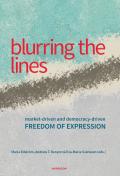Tillbaka
 Förlag:
Förlag: Nordicom
Mediatyp: Bok
Bandtyp: Häftad
Utgiven: 2022-10-19
Språk: Engelska
Vikt: 396g
ISBN: 87957-36-9
|
Blurring the lines. Market-driven and democracy-driven freedom of expression
(Häftad)
Ej i detta bibliotek
Kategori:
Allmänt och blandat - Allmänt (Bs)
Beskrivande text
The overall aim of this book is to focus on challenges from the market to free speech and how free speech can be protected, promoted and developed in a time when the lines between journalism and advertising are blurred. Its scope covers both structural and individual levels. It analyses tensions between what can be called democracy-driven and market-driven freedom of expression (terms that are considered below). Specifically, the book embraces three contemporary tensions and debates. In part I, the focus is on the governance of freedom of expression and the varied possible roles of the state in protecting and securing free speech; part II examines the contemporary conditions of the media market and their connections with journalism and other forms of public speech; and part III considers various restrictions and control of media content, both regulatory and self-regulatory. The book seeks to develop new perspectives on the relations between actors such as the state, market, media and civil society.
The collection is multi-disciplinary, with contributions from scholars in law, media studies and philosophy. It is also a result of a research project combining law and journalism studies. Almost all the chapters were developed through intense discussions of papers during the two day conference, Communicative Democracy. The transnational discussions between scholars based in Austria, Finland, Germany, Norway, Spain, Sweden, the UK, USA and Australia highlighted both similarities and striking differences between various legal cultures concerning freedom of expression and media systems. The debate in these (western) parts of the world seems to have had a bias in favour of American and English perspectives, particularly within law and media studies scholarship. But other western legal cultures and media systems have other ways of handling free speech, which can offer interesting ideas for scholars in many countries. Our ambition in this book is to give voice to some of these other ways to deal with free speech, to offer an encounter between them and more traditional Anglo-American approaches, and to reframe the terrain of free speech analysis, if just a little.
General themes … or, in Swedish parlance, “red threads”
To capture one set of tensions between different perceptions of free speech and its relation to various values, we have developed the conceptual distinction between democracy-driven and market-driven freedom of expression (Svensson & Edström 2014; Edström & Svensson 2016). As Edström and Svensson have explained (2016:69), this distinction signifies two ideal types or rationalities used to understand and explain processes that can be seen primarily on an aggregated level as well as to capture a tension between the two rationalities themselves. The concepts market-driven and democracy-driven freedom of expression are understood as two ends of a continuum, driven by different rationalities and assumptions. Even though both promote the idea of extensive freedom of expression, they differ in several respects. Some important differences involve: how freedom of expression, particularly in terms of public speech, is framed and anchored in a broader context of democracy and economy, how the core elements of freedom of expression are perceived, and the role of journalism and how that is safeguarded. There are also other issues. Which expressions should be protected from (potential) state limitation, is one. Another is how different types of expression are conceptualised and valued, in terms of ‘political’ speech, ‘commercial’ speech, and so forth. And there are questions about which legal subjects’ interests should be protected and who (or what) should determine the boundaries of free speech (ibid.).
|